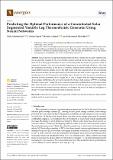Predicting the Optimal Performance of a Concentrated Solar Segmented Variable Leg Thermoelectric Generator Using Neural Networks
Author(s)
Maduabuchi, Chika; Fagehi, Hassan; Alatawi, Ibrahim; Alkhedher, Mohammad
Downloadenergies-15-06024-v2.pdf (9.786Mb)
Publisher with Creative Commons License
Publisher with Creative Commons License
Creative Commons Attribution
Terms of use
Metadata
Show full item recordAbstract
The production of high-performing thermoelectrics is limited by the high computational energy and time required by the current finite element method solvers that are used to analyze these devices. This paper introduces a new concentrating solar thermoelectric generator made of segmented materials that have non-uniform leg geometry to provide high efficiency. After this, the optimum performance of the device is obtained using the finite element method conducted using ANSYS software. Finally, to solve the high energy and time requirements of the conventional finite element method, the data generated by finite elements are used to train a regressive artificial neural network with 10 neurons in the hidden layer. Results are that the power and efficiency obtained from the optimized device design are 3× and 2× higher than the original unoptimized device design. Furthermore, the developed neural network has a high accuracy of 99.95% in learning the finite element data. Finally, the neural network predicts the modified device performance about 800× faster than the conventional finite element method. Overall, the paper provides insights into how thermoelectric manufacturing companies can harness the power of artificial intelligence to design very high-performing devices while saving time and cost.
Date issued
2022-08-19Department
Massachusetts Institute of Technology. Department of Nuclear Science and EngineeringPublisher
Multidisciplinary Digital Publishing Institute
Citation
Energies 15 (16): 6024 (2022)
Version: Final published version